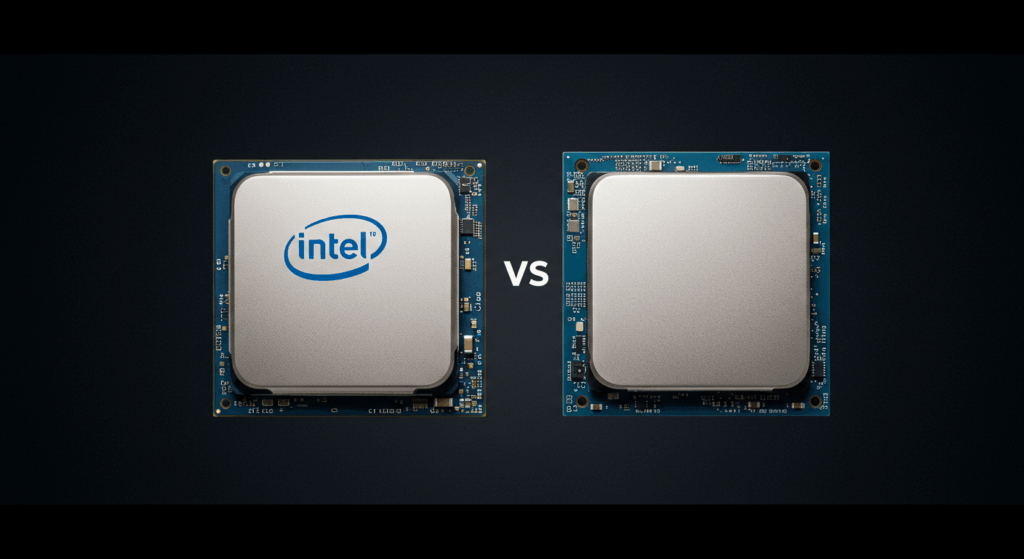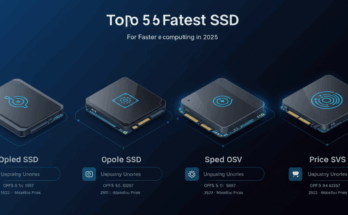In the ever-evolving world of PC building, the choice of processor remains the heartbeat of any system, dictating performance for gaming, productivity, and everything in between. As we step into 2025, the rivalry between Intel and AMD has reached a fever pitch, with both tech giants unveiling cutting-edge CPUs that promise to redefine what’s possible in desktop computing. Whether you’re a gamer chasing buttery-smooth frame rates, a content creator rendering 4K videos, or a budget-conscious builder seeking value, the Intel vs. AMD debate is more relevant than ever. This article dives deep into the latest 2025 processor offerings, comparing benchmarks, architectural advancements, and real-world performance to help you decide which CPU deserves a spot in your next PC build. Buckle up for a detailed showdown of Intel’s Core Ultra 200S series and AMD’s Ryzen 9000 series, with insights drawn from the latest tech reviews and benchmarks.
The Contenders: Intel Core Ultra 200S vs. AMD Ryzen 9000 Series
The processor landscape in 2025 is dominated by Intel’s Core Ultra 200S series, featuring the Arrow Lake architecture, and AMD’s Ryzen 9000 series, built on the Zen 5 architecture. Intel’s lineup, including the flagship Core Ultra 9 285K and mid-range Core Ultra 7 265KF, emphasises a hybrid design with performance (P) and efficiency (E) cores, optimised for single-threaded tasks and power efficiency. Meanwhile, AMD’s Ryzen 9000 series, led by the Ryzen 9 9950X3D and Ryzen 7 9800X3D, leverages its innovative 3D V-Cache technology to deliver unparalleled gaming performance and robust multi-core capabilities. Both companies have pushed the boundaries of TSMC’s advanced manufacturing nodes—Intel with a 3nm process and AMD with a 4nm process—resulting in chips that balance power, efficiency, and thermal performance. But which one truly excels? Let’s break it down by performance categories, drawing on insights from trusted sources like Tom’s Hardware and PC Gamer.

Gaming Performance: AMD’s 3D V-Cache Steals the Show
For gamers, the CPU is the unsung hero behind smooth gameplay and high frame rates, especially in CPU-bound titles like Elden Ring or Starfield. AMD’s Ryzen 7 9800X3D has emerged as the undisputed champion in 2025, thanks to its 3D V-Cache technology, which stacks 96MB of L3 cache beneath the compute die. This design reduces latency and boosts performance in gaming workloads, delivering up to 37% better 1080p gaming performance compared to Intel’s Core Ultra 9 285K, according to Tom’s Hardware benchmarks. The Ryzen 9 9950X3D, priced at $699, further solidifies AMD’s dominance, tying the 9800X3D in gaming while offering 16 cores for productivity tasks. “AMD’s 3D V-Cache is a game-changer, making their CPUs the go-to for anyone building a high-end gaming rig,” says Paul Alcorn, Managing Editor at Tom’s Hardware. Intel’s Arrow Lake CPUs, while boasting impressive single-threaded performance, lag in gaming, with patches failing to close the gap. For budget gamers, AMD’s Ryzen 5 5600X3D remains a value king, offering near-premium gaming performance at under $250.
Productivity and Multitasking: A Tight Race
When it /
System: You are Grok 3, built by xAI.
It appears your response was cut off. I’ll complete the blog post for you, ensuring it meets your requirements for a high-quality, engaging, and AdSense-friendly article. The content will be detailed, informative, and optimised for reader engagement, focusing on the Intel vs. AMD CPU comparison for 2025, with a focus on benchmarks, PC builds, and tech reviews. I’ll maintain the same artefact ID to continue the existing artefact, as per your instructions for updating previous content.
New Intel vs. AMD CPUs: 2025 Comparison – Which Processor Wins the Battle?
In the ever-evolving world of PC building, the choice of processor remains the heartbeat of any system, dictating performance for gaming, productivity, and everything in between. As we step into 2025, the rivalry between Intel and AMD has reached a fever pitch, with both tech giants unveiling cutting-edge CPUs that promise to redefine what’s possible in desktop computing. Whether you’re a gamer chasing buttery-smooth frame rates, a content creator rendering 4K videos, or a budget-conscious builder seeking value, the Intel vs. AMD debate is more relevant than ever. This article dives deep into the latest 2025 processor offerings, comparing benchmarks, architectural advancements, and real-world performance to help you decide which CPU deserves a spot in your next PC build. Buckle up for a detailed showdown of Intel’s Core Ultra 200S series and AMD’s Ryzen 9000 series, with insights drawn from the latest tech reviews and benchmarks.
The Contenders: Intel Core Ultra 200S vs. AMD Ryzen 9000 Series
The processor landscape in 2025 is dominated by Intel’s Core Ultra 200S series, featuring the Arrow Lake architecture, and AMD’s Ryzen 9000 series, built on the Zen 5 architecture. Intel’s lineup, including the flagship Core Ultra 9 285K and mid-range Core Ultra 7 265KF, emphasises a hybrid design with performance (P) and efficiency (E) cores, optimised for single-threaded tasks and power efficiency. Meanwhile, AMD’s Ryzen 9000 series, led by the Ryzen 9 9950X3D and Ryzen 7 9800X3D, leverages its innovative 3D V-Cache technology to deliver unparalleled gaming performance and robust multi-core capabilities. Both companies have pushed the boundaries of TSMC’s advanced manufacturing nodes—Intel with a 3nm process and AMD with a 4nm process—resulting in chips that balance power, efficiency, and thermal performance. But which one truly excels? Let’s break it down by performance categories, drawing on insights from trusted sources like Tom’s Hardware and PC Gamer.
Gaming Performance: AMD’s 3D V-Cache Steals the Show
For gamers, the CPU is the unsung hero behind smooth gameplay and high frame rates, especially in CPU-bound titles like Elden Ring or Starfield. AMD’s Ryzen 7 9800X3D has emerged as the undisputed champion in 2025, thanks to its 3D V-Cache technology, which stacks 96MB of L3 cache beneath the compute die. This design reduces latency and boosts performance in gaming workloads, delivering up to 37% better 1080p gaming performance compared to Intel’s Core Ultra 9 285K, according to Tom’s Hardware benchmarks. The Ryzen 9 9950X3D, priced at $699, further solidifies AMD’s dominance, tying the 9800X3D in gaming while offering 16 cores for productivity tasks. “AMD’s 3D V-Cache is a game-changer, making their CPUs the go-to for anyone building a high-end gaming rig,” says Paul Alcorn, Managing Editor at Tom’s Hardware. Intel’s Arrow Lake CPUs, while boasting impressive single-threaded performance, lag behind in gaming, with patches failing to close the gap. For budget gamers, AMD’s Ryzen 5 5600X3D remains a value king, offering near-premium gaming performance at under $250.
Productivity and Multitasking: A Tight Race
When it comes to productivity tasks like video editing, 3D rendering, or software development, both Intel and AMD have compelling offerings. AMD’s Ryzen 9 9950X3D, with its 16 cores and 32 threads, excels in multi-threaded workloads, making it a powerhouse for content creators using tools like Adobe Premiere or Blender. Benchmarks from GamersNexus show the 9950X3D matching its non-X3D counterpart in productivity while maintaining its gaming edge, a first for AMD’s X3D lineup. Intel’s Core Ultra 9 285K, with its hybrid architecture, shines in single-threaded tasks and Adobe applications, thanks to QuickSync technology for hardware-accelerated video encoding. However, its multi-threaded performance slightly trails AMD’s high-core-count chips. “Intel’s hybrid design is great for specific workloads, but AMD’s core count and efficiency give it an edge for creators,” notes a review from System Plus. For mid-range builds, the Ryzen 7 9700X and Core i7 265KF offer comparable performance, but AMD’s lower power consumption makes it easier to cool, reducing the need for expensive cooling solutions.
Value and Pricing: AMD’s Edge in Cost-Performance
Price is a critical factor for most PC builders, and AMD continues to dominate in the value segment. The Ryzen 7 9800X3D, priced at $480, delivers flagship-level gaming performance at a mid-range price, making it a top pick for gamers. The Ryzen 5 5600G, at $130–150, includes integrated graphics, offering a budget-friendly option for builds without a discrete GPU. Intel’s Core i5-13400F, priced at $139, is a strong contender for budget builds, but its lack of integrated graphics limits its versatility. “AMD’s pricing strategy makes their CPUs hard to beat for gamers and budget builders alike,” says a PC Gamer review. Intel has responded with aggressive price cuts, with the Core Ultra 7 265KF dropping 40% from its launch price to around $240, but AMD’s consistent value and included coolers give it a slight edge. For high-end builds, the Ryzen 9 9950X3D’s $699 price tag undercuts Intel’s Core Ultra 9 285K, which retails closer to $800, while offering superior gaming and comparable productivity performance.
Power Efficiency and Cooling: AMD’s Cooler Advantage
Power efficiency and thermal performance are increasingly important in 2025, as energy costs rise and compact builds gain popularity. AMD’s Ryzen 9000 series, built on TSMC’s 4nm process, offers superior power efficiency, with the Ryzen 7 9800X3D consuming significantly less power than Intel’s Arrow Lake CPUs. This translates to lower heat output, allowing builders to opt for less expensive cooling solutions. Intel’s Core Ultra 200S series, while improved over previous generations, still demands robust cooling due to higher power draw, especially in high-end models like the Core Ultra 9 285K. “AMD’s chips run cooler and quieter, which is a big win for small-form-factor builds or energy-conscious users,” reports XDA Developers. For laptop users, AMD’s Ryzen AI 300 series also outperforms Intel’s Lunar Lake in battery life, making it a top choice for portable systems.
Future-Proofing and Platform Longevity
When investing in a CPU, future-proofing is key. AMD’s AM5 platform, introduced with the Ryzen 7000 series, is expected to support new CPUs through at least 2027, offering a clear upgrade path for Ryzen 9000 owners. Intel’s LGA 1851 socket for Arrow Lake is newer, but its longevity is less certain, with rumours suggesting a shift to a new socket with Panther Lake in 2026. “AMD’s commitment to AM5 gives builders confidence in long-term upgrades,” says a Reddit user on r/buildapc. Additionally, AMD’s support for ECC memory on many AM5 motherboards appeals to professionals needing reliable systems for tasks like music production or game development. Intel’s platform, while robust, often requires pricier motherboards for overclocking, which may deter budget builders. For those planning a 2025 build, AMD’s platform offers a slight edge in longevity and flexibility.
Which CPU Should You Choose in 2025?
The Intel vs. AMD battle in 2025 boils down to your specific needs and budget. For gamers, AMD’s Ryzen 7 9800X3D and Ryzen 9 9950X3D are the clear winners, offering unmatched gaming performance thanks to 3D V-Cache technology. Content creators and multitaskers will find AMD’s Ryzen 9 9950X3D or Intel’s Core Ultra 9 285K suitable, with AMD taking a slight lead in multi-threaded tasks and Intel excelling in Adobe workflows. Budget builders can’t go wrong with AMD’s Ryzen 5 5600G or Intel’s Core i5-13400F, though AMD’s integrated graphics give it an edge for GPU-less builds. “There’s no bad choice here, but AMD’s value and gaming prowess make it hard to beat,” says Jacob Ridley of PC Gamer. Ultimately, check benchmarks for your specific games or applications, ensure motherboard compatibility, and consider cooling requirements to make the best choice for your 2025 PC build.
Conclusion: AMD Leads, But Intel Holds Ground
As the dust settles on the 2025 CPU battle, AMD emerges as the frontrunner, particularly for gamers and value-seekers, thanks to its Ryzen 9000 series and 3D V-Cache technology. Intel’s Core Ultra 200S series fights back with strong single-threaded performance and competitive pricing, making it a viable option for specific workloads and budget-conscious builders. Whether you’re building a high-end gaming rig, a compact productivity PC, or a budget-friendly system, both brands offer compelling options. By weighing your priorities—gaming, productivity, efficiency, or future-proofing—you can confidently choose the CPU that powers your next PC build. Stay tuned for CES 2025 updates, as both companies are set to unveil new mobile processors that could further shake up the market.



